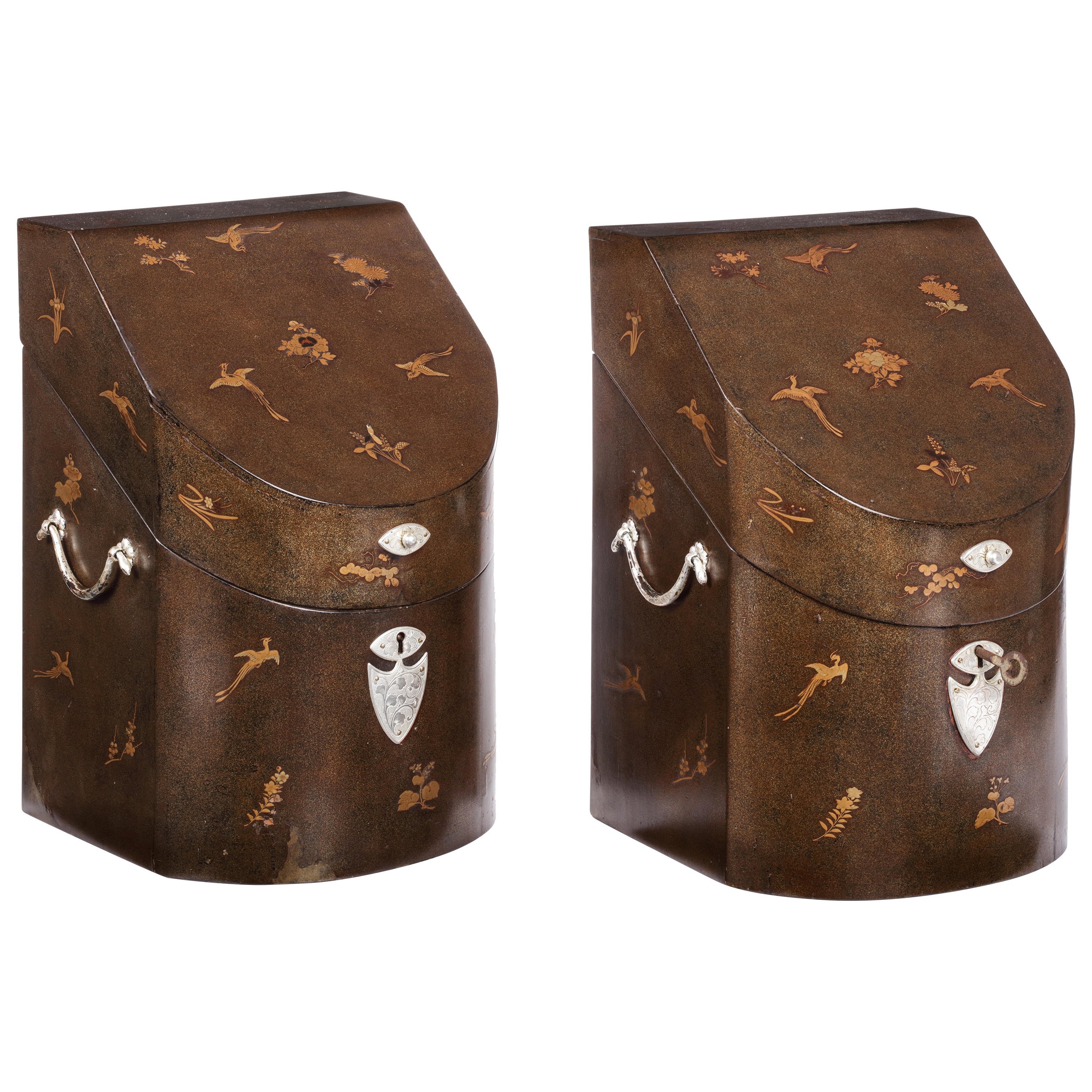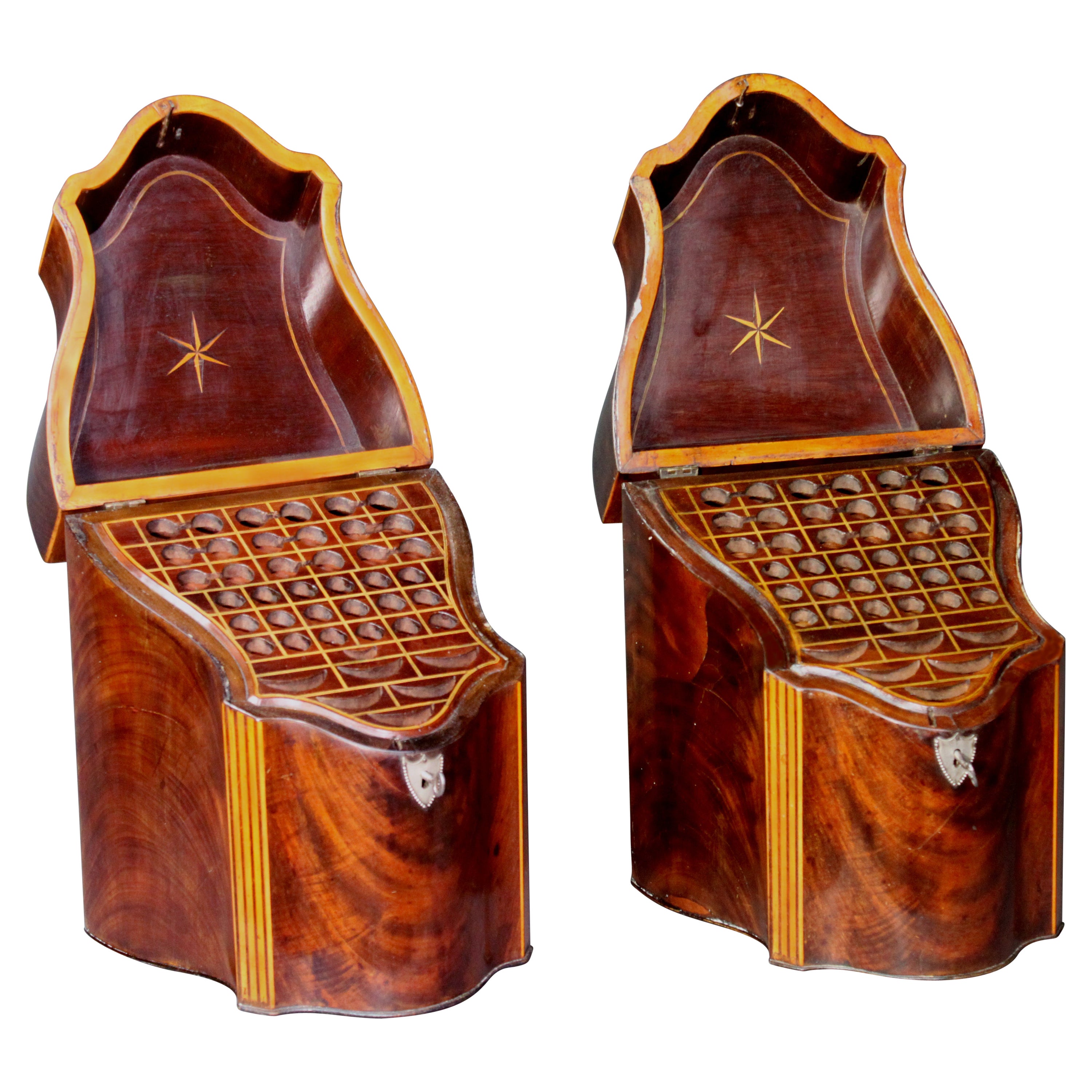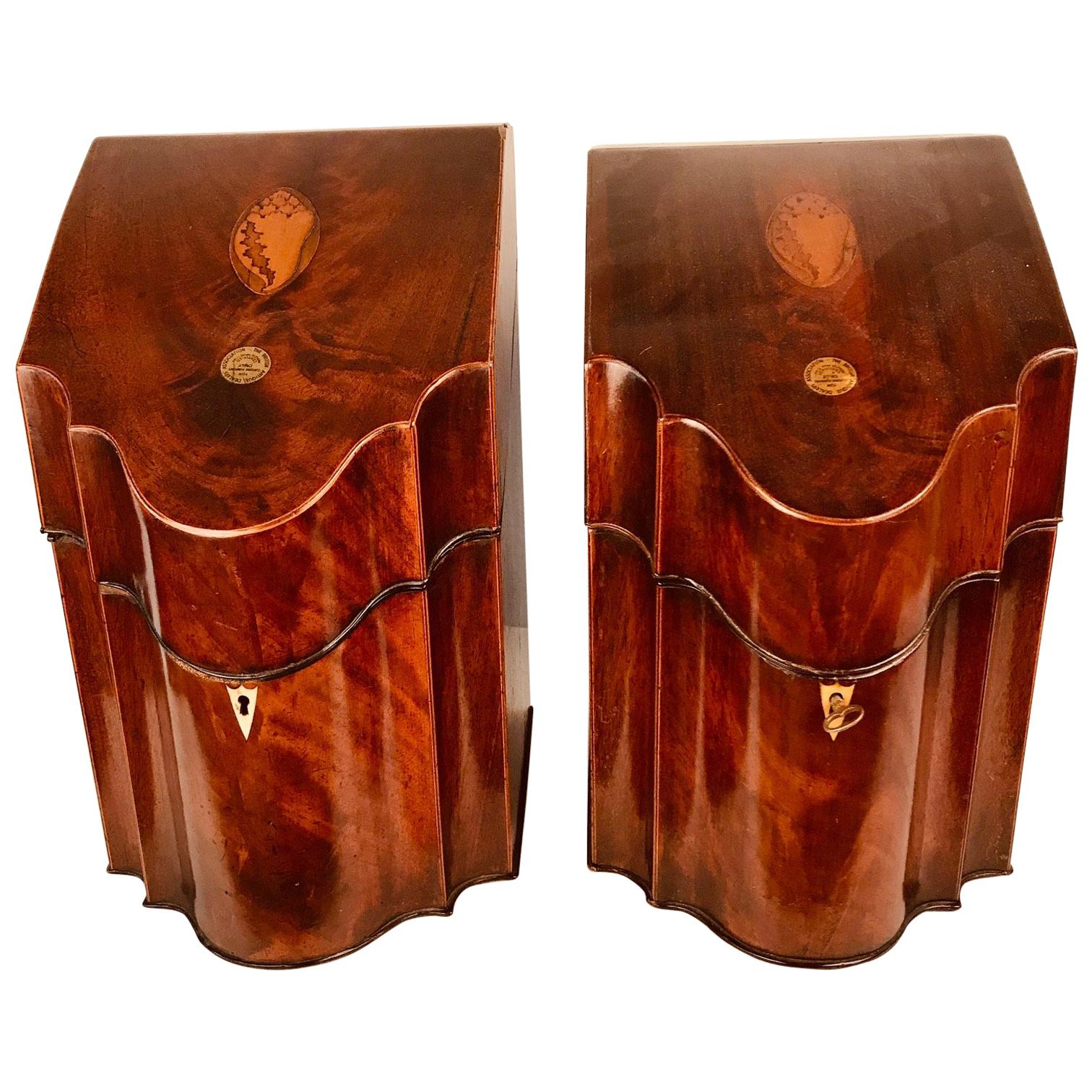Items Similar to Rare pair of Japanese Nagasaki Export Lacquered Wood Knife Boxes
Want more images or videos?
Request additional images or videos from the seller
1 of 16
Rare pair of Japanese Nagasaki Export Lacquered Wood Knife Boxes
About the Item
Rare pair of Japanese Nagasaki Export lacquered wood knife boxes with mother-of-pearl inlay of flowers and birds, now converted to letter boxes. The boxes were converted to letter boxes in the late 19th c. as shown in photograph.
From Sutton Place townhouse of the Heinz family.
FW 1654
- Dimensions:Height: 13.5 in (34.29 cm)Width: 8.75 in (22.23 cm)Depth: 7.5 in (19.05 cm)
- Sold As:Set of 2
- Style:Anglo-Japanese (Of the Period)
- Materials and Techniques:Wood,Lacquered
- Place of Origin:
- Period:
- Date of Manufacture:1800
- Condition:Additions or alterations made to the original: Converted to letter boxes as mentioned in the description. Wear consistent with age and use. Ready to place.
- Seller Location:Stamford, CT
- Reference Number:
About the Seller
4.9
Vetted Seller
These experienced sellers undergo a comprehensive evaluation by our team of in-house experts.
Established in 1999
1stDibs seller since 2011
522 sales on 1stDibs
Typical response time: 2 hours
- ShippingRetrieving quote...Ships From: Stamford, CT
- Return PolicyThis item cannot be returned.
More From This SellerView All
- Black and Gold Lacquer Japanese Suzuribako BoxLocated in Stamford, CT19th century Japanese black and gold lacquer Suzuribako box with firefly and plum blossom design.Category
Antique Late 19th Century Japanese Decorative Boxes
MaterialsLacquer
- Lacquer PotpourriLocated in Stamford, CTLacquer Potpourri box and cover with ormolu mountings from 18th century Directoire Japan/ France.Category
Antique 18th Century Japanese Lacquer
MaterialsLacquer
- Pair of Chinese Export Joss SticksLocated in Stamford, CTA pair of Chinese Export porcelain elephants as joss sticks. Canton Rose Famille.Category
Antique 19th Century Chinese Candle Holders
MaterialsPorcelain
- Pair of Lacquered Carved Wood Pedestals in the Manner of William KentLocated in Stamford, CTA pair of carved wood pedestals now lacquered in the manner of William Kent.Category
Antique Late 19th Century English Pedestals and Columns
MaterialsWood
- Japanese Edo-Meiji Period Lacquered PalanquinLocated in Stamford, CTA Japanese Edo-Meiji period Palanquin chair for the childrens festival. The form with sliding and hinged doors, decorated in gold hiramaki-e with peonies ...Category
Antique 1890s Japanese Edo More Asian Art, Objects and Furniture
MaterialsLacquer
- Japanese Sterling & Mixed Metal BoxLocated in Stamford, CTA Japanese sterling silver and mixed metal box with tray over wood.Category
Antique Late 19th Century Japanese Meiji Decorative Boxes
MaterialsSilver
You May Also Like
- Pair of Fine Japanese Export Lacquer Cutlery Knife Boxes, 18th CenturyLocated in Amsterdam, NLA pair of fine Japanese export lacquered cutlery boxes Kyoto or Nagasaki, late 18th century H. 33.5 x W. 24 x D. 21 cm The bow-fronted boxes with sloping lids flat at the top are made of hinoki wood (Cypress), coated with Japanese paper and decorated in lacquer with scattered gold birds and flowers on a nashiji background. The Japanese mounts are made of copper and both boxes still have internal partitions to keep the cutlery upright. The form of these boxes is similar to a pictorial-style knife box in the collection of the Groninger Museum (inv. 1989- 347), dated between 1730 and 1780, but the style of the decoration is more like that on a knife box in the Peabody Essex Museum in Salem (inv. E62271), which was brought to Salem by James Devereux, Captain of the Franklin, in 1799. Provenance: Henriette Jeane Christine van Neukirchen, called Nyvenheim (1807- 1849) and Nicolaas Johan Steengracht van Oostcapelle (1806-1866), thence by descent to the last owners, Ludolphine Emilie baronesse Schimmelpenninck van der Oye (1944) married in 1969 to Roland Daniel van Haersma Buma (1944), the last residents of castle Duivenvoorden near Voorschoten and the great-great-granddaughter of Nicolaas Johan Steengracht van Oostcapelle. There is no evidence that Nicolaas Johan himself, or any of his or his wife’s ancestors had ever been in Japan. However, Nicolaas’ grandfather (Nicolaas Steengracht, 1754-1840) was a director of both the VOC and WIC (West Indies Company...Category
Antique Late 18th Century Japanese Lacquer
MaterialsSilver
- Pair of Japanese Lacquer and Mother-of-Pearl Inlaid Knife Urns, circa 1800-1815Located in Amsterdam, NLA rare pair of Kyoto-Nagasaki style lacquer and mother-of-pearl inlaid knife urns Edo period, early 19th century Measures: Height 71 x diameter 30 cm ?Formed as urns with vertically lifting covers and elongated finials, revealing fitted green velvet lined interiors for knives, decorated overall with birds, flowering stems, faux-fluting and oval panels with landscapes. The square plinth is raised on four bracket feet. Inside the lifting cover of one of the urns are Japanese characters, supposedly indications of some code by the craftsman. A closely related knife urn, now in the collection of the Peabody Essex Museum, Salem (inv. E 73115), was acquired in Nagasaki by Captain Samuel Gardner Derby of the Margareth of Salem in 1801. Captain Gardner Derby traded in Nagasaki under charter from the VOC (Vereenigde Oostindische Compagnie), the Dutch East India Company. Between 1797 and 1814 Holland was occupied by the French and from 1811 until 1816 Java by the English. During these periods practically no Dutch shipping was possible between Holland and Batavia (Jakarta) or between Batavia (Jakarta) and Nagasaki. To maintain a minimum amount of shipping between Batavia (Jakarta) and Nagasaki, between 1797 and 1807, the VOC chartered mainly American ships. American captains and officers ordered and bought mainly lacquered furniture in an American-English style, completely different from what the Dutch up till then had ordered. The present knife urns were possibly also ordered and acquired by Captain Gardner Derby during his stay in Deshima/Nagasaki in 1801. Another similarly neoclassical shaped knife urn in the collection of the Ashmolean Museum Oxford (inv. 1996.17) appears to be signed by woodworker Kiyotomo koreo tsukuru (Kiyomoto made this). The same name, together with an address in the Sanjo-Teramachi District of Kyoto, has been found inside a fragmentary urn in a private collection. This is an indication that European-style furniture was not only lacquered in Japan but made there as well. This undoubtedly is not only true for knife-urns, but all European- style furniture lacquered in Japan after circa 1800 was made by Japanese furniture makers...Category
Antique Early 19th Century Japanese Anglo-Japanese Lacquer
MaterialsBrass
- Pair of Georgian Knife BoxesBy Thomas SheratonLocated in Bradford-on-Avon, WiltshireFine pair of George III Sheraton Period figured mahogany knife boxes with striking boxwood stringing, silver plated mounts and the original fitted interiors....Category
Antique Late 18th Century English George III Knife Boxes
MaterialsMahogany
- Pair of Regency Satinwood Knife BoxesLocated in New York, NYWith mahogany banding and checkerbanding throughout; with slanted, hinged lid opening to a fitted interior.Category
Antique Early 19th Century English Regency Knife Boxes
MaterialsMahogany
- Pair of George III Mahogany Knife BoxesLocated in Montreal, QCThis pair have the typical shape of boxes from this period, with shaped serpentine front, sloped hinged lid, and boxwood and ebony lines. Each cover is inlaid with an oval patera and...Category
Antique Early 19th Century British George III Knife Boxes
MaterialsMahogany
- Pair of Fine English Georgian Mahogany Knife BoxesLocated in Bridgeport, CTA particularly fine pair of knife boxes with banded mahogany slanted hinged lids and shaped fronts. The interior with inlaid satinwood star motifs ...Category
Antique 19th Century English Georgian Knife Boxes
MaterialsMahogany
Recently Viewed
View AllMore Ways To Browse
Kitchen Knife
Antique Kitchen Box
Antique Knife
Browning Knife
Antique Silver Knife
Antique Glass Knife
Antique Kitchen Knife
Silver Box Japan
Japanese Silver Box
Wood And Silver Inlay
Glass Birds Pair
Pair Of Silver Birds
Japanese Glass Flowers
Knife Box With Knifes
Antique Japanese Lacquer Box Boxes
Japanese Antique Lacquer Box Boxes
Antique Japanese Wood Box
Antique Knife Boxes





